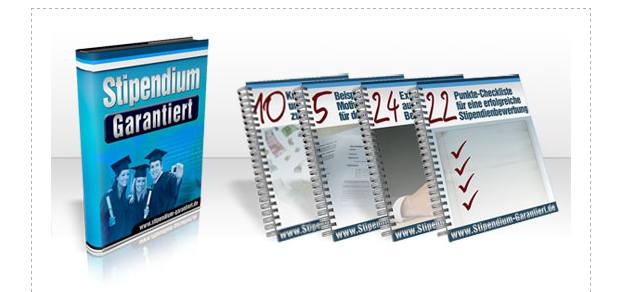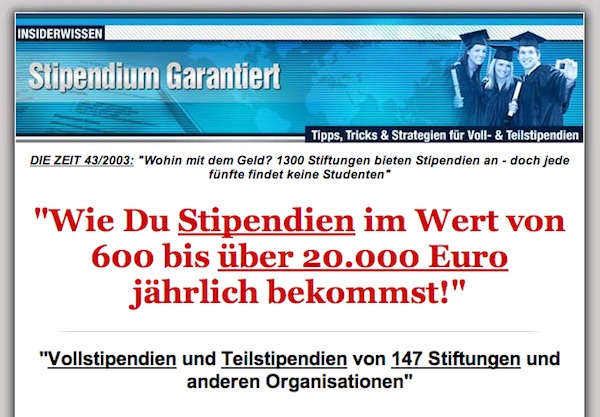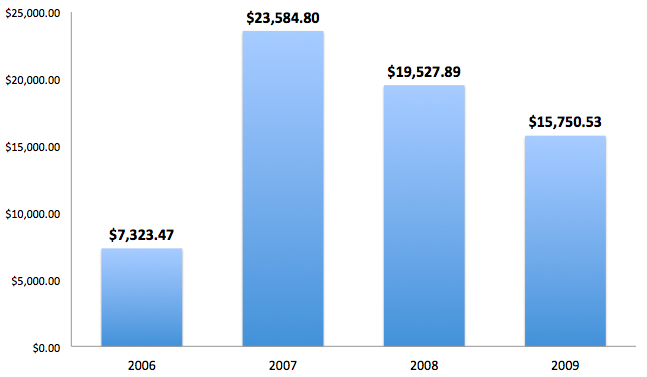How To Sell Information Products (Six-Figure Case Study)

My favorite research tool: idea books
In 2006, I was a freshman at a college in the Netherlands. I spent my days learning about accounting, finance and economics and my nights teaching myself online marketing.
In June 2006 I launched my very first product online: a self-published guide on how to find student grants in Germany. It turned out to be an immediate success.
Here are a few key points about the product:
- The product generated six-figures in revenue over a period of 3.5 years
- I built an email list of 10,000 subscribers on the side
- After the initial setup it was an automated business generating an average of $19k in profit per year
- The product was only sold through highly optimised Google Adwords campaigns
- No affiliates, no email marketing except through my own list
I have since repeated this process in larger and more profitable markets (which I will write about in the future too).
If you are interested in selling a digital product online, this case study will give you a good idea of how much income a small niche product can generate and how to make it happen.
Market Research Process And How I Selected The Niche
I did a lot of research before before selecting the niche for my first product. My research process involved an idea book and some online tools.
Whenever I came across a market I found interesting I wrote it down in my idea book. I would then type in the main keyword for the market in the Google Adwords Keyword Tool (now called Keyword Planner).
This provided me with two interesting metrics:
1. monthly search volume for the niche
2. average cost per click
In hindsight, I had a bit of luck that I selected the right kind of niche even though it was my first product online. In 2006 the student grants niche had a monthly search volume of around 100,000 searches. The average cost per click was around 10 cents.
From then onwards I used 100,000 monthly searches as a minimum for deciding whether to enter a niche market or not.
I’ve found that this market size is large enough to build a significant income stream on the side; anything greater than 100,000 searches per month is obviously even better.
For my product I estimated an average conversion rate of 1%. Given the average cost per click in the market I calculated that to generate a sale I would have to spend around $10.
In terms of my initial forecast it turned out that I had made very conservative estimates. I was hoping to generate around $500 to $600 in profits per month. The product ended up generating several multiples in profits per month.
Lastly, I decided on the student niche because at the time I was a student myself so I felt like I could relate to the market.
Product Details, Positioning And Pricing

Product Covers I Used To Market The Book
As a first step I created a very lean version of the book. I sat down during my summer break to write a 30-page guide on how to find student grants in Germany. I then created a landing page outlining the details of the product.
As part of the first test I set a relatively low price of 9.90 €. Over the course of the following months I continued to increase the price.
Within three months I had doubled the price from 9.90 € to 19.95 € with intermediate price points of 12.90 € and 18.90€. About six months after the initial launch there was a final price increase (24.95 €).
Every price increase was preceded by an improvement of the product. At first I focussed on expanding the main book from around 30 pages to 240+ pages.
Later I continued to add helpful bonuses to the product. The final offer consisted of a 240+ page book and four 5 – 25 page bonuses.
With every price increase I also kept monitoring the overall conversion rate, revenues and profits. After experimenting with a variety of price points I determined that 24.95 € was the ideal price for the product.
The main product was designed to help students find grants. A year later I created a second product that assisted students with the application process. The upsell sold for 17.90 €.
The Sales Page And Conversion Process

“How To Find Student Grants Worth 600 To 20,000+ Euros”
The screenshot above shows the final version of the sales letter. The style and design looks old school these days but it converted like a charm from 2006 to 2009.
The landing page had every element of a traditional sales letter:
- A strong headline that got visitors curious
- Long form copy addressing the problems and pain points of prospects
- Description of the product details with benefits
- Description of the bonuses + benefits
- A 365-day money back guarantee (always honoured without any questions asked, details on refund rates later)
- A list of testimonials from customers
Over the first year of marketing the product I continued to improve the design and copy of the sales page. Every change on the sales page was based on statistically significant results from A/B split tests using the Google website optimizer tool (now called Google Analytics Content Experiments).
In total, I ran about 10 split tests on the sales page most of which improved the sales conversion rate by 10 – 20%.
For my first test of the product my only payment option was Paypal. I soon introduced a second option to pay via direct debit which is the most popular payment option in Germany. Offering these two payment options turned out to be an ideal combination.
Further, I experimented with different conversion processes. For a while I sent visitors to an opt-in page offering a free email course with the intention of selling the product on the backend. This turned out not to convert as well as sending people straight to the sales letter.
My final setup sent people straight to the sales letter with a hover ad fading in after about 5 seconds. The hover ad offered the same free email course. This setup worked very and generated an email list of close to 10,000 email subscribers on the side.
Besides marketing my product to the email list I turned out to be a great research tool as well. One time I sent an email to the list asking subscribers about their most creative ideas to finance their studies. The response was amazing.
One girl sent me photos of drawings which she was selling through local coffee shops. Another subscriber sent valuable tips on finding well-paid student jobs.
There was so much good feedback that I packaged it all into 25-page document and gave it away as an additional free bonus with the main product.
How I Sold The Product Using Highly Optimized Google Adwords Campaigns

Screenshot of the Adwords campaign metrics in Euros. Below I have converted all figures to US Dollars
Google Adwords was the first channel where I tested the product and it continued to be the best converting channel over the entire life of the product.
I spent some time working on organic rankings for the product but the conversion rates were much lower compared to the Adwords campaign.
Over the entire duration of the campaign I spent a little more than $30k on Google Adwords (€22,320.51).
The conversion tracking wasn’t working perfectly. I would estimate that 10 – 20% of the conversion were not tracked. So the average conversion rate over the entire campaign history was slightly higher than 1%.
The average advertising cost per sale was roughly $10. This left a profit of around $20 per sale excluding any upsells and backend email marketing.
Only about 5% of all buyers asked for a refund. This includes cancelled payments due to insufficient balance on the buyer’s bank account. For a digital product this is a very low refund rate. If you do some research on refund rates for digital products you will find that figures between 10 and 20% are the average.
I attribute the low conversion rate to the overall value of the product. This was backed by a 365-day money back guarantee. However, almost all refunds happened during the first few days.
Over the entire duration of the campaign I continued to refine the ads to improve the results. Some of my ads were getting click through rates above 10% on the Google search network. The click through rate figure in the graph above includes the display network which pulls the average down significantly.
Roughly 80% of my budget was spent on the Google search network and 20% on the Google display network. The conversion rate on the display network was slightly lower than on the search network.
An area that I didn’t explore were direct media buys on relevant websites. There are many large content websites targeting the student market in Germany. This would have further improved the results from display traffic.
Yearly Profit And Concluding Thoughts

Over the entire product life the book generated close to $100k in revenues ($97,967.81). The total advertising budget was $31,781.12. This left an overall profit of $66,186.69.
Here’s the profit breakdown between 2006 and 2009:
- 2006: $7,323.47 (June – December)
- 2007: $23,584.80
- 2008: $19,527.89
- 2009: $15,750.53
The product was only launched in June 2006 which explains the low revenue figure for 2006. 2007 and 2008 were the best years in terms of profits.
By 2008 there were some new websites in the German market which offered databases for searching student grants. In order to keep up with the developments in the markets I would have had to transition to a database model with custom search features.
However, I had already started working on products in larger niche markets and had therefore neglected my very first product. At the end of 2009 I decided to take the product off the market.
After the upfront work of creating the product and the initial optimizations on the website, the only time spent on the business was less than an hour per week answering customer emails. This is as close as one gets to passive income.
This case study should give you a good idea of how much a product in a small niche can generate in income per month.
In the future I will write up a case study contrasting another one of my products in a different market which has generated up to $20k per month, again just sold through Google Adwords campaigns without any affiliates or email lists from other people.

This is great stuff – I have a lot of reading to do the upcoming week:)
Do you still live in The Netherlands? If so, maybe we can meetup sometime as fellow bloggers and online marketeers.
Hi Derrek, thanks for the comment!
I don’t live in the Netherlands anymore. But I’ll let you know if I make it out there again some time 🙂
Wow, great case study!! I really appreciate and enjoy the transparency about how you went the whole process. Also, nice insights into what you need for a high converting landing page and the value of split testing. Great stuff 🙂
Thanks!!
Thanks mate. Glad to hear you enjoyed it!
Interesting read, thanks for that!
Back when I did a lot of Adwords I always disliked informational search queries as you can’t sell to those people.
Unless you have an information product, obviously. Hadn’t thought about that before 🙂
Best
Patrick
Thanks Patrick. Yeah it can work really well in the right niche 🙂
Fantastic write up Stefan. Thanks for the transparency, really cool to see. I guess in your spare time you were playing basketball.
Thanks Derek, we need to shoot some hoops again!
Stefan, thank you for being an inspiration. Also, thank you for sharing your business tactics with others.
Best of luck to you in the future, I look forward to subscribing to your marketing lessons and reading your blog.
Best,
Mason
Thanks for commenting Mason! Happy to share this case study.
Fantastic article. Thank you Stefan for sharing your experience. I’ve a question for you – could you explain the process of your research in a little more detail? (or perhaps point us towards another article)
The whole Google Keyword Planner I find a little confusing. I would love a comprehensive explanation of how experts like yourself use it.
Thanks again,
Cameron
Hi Cameron,
Thanks for your comment. I’ve touched on my research process in two other articles on the blog which might be helpful:
http://www.stefanmaescher.com/selling-digital-products-from-anywhere/
http://www.stefanmaescher.com/the-power-of-idea-books/
I mainly use the Google keyword planner to get a feeling for the overall size of a niche.
It’s a good idea to start looking at search volumes for markets that you are already familiar with and then compare those to new ideas. Rather than just looking at absolute numbers this will give you a better frame of reference.